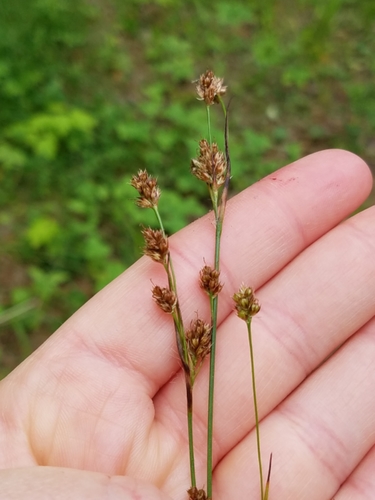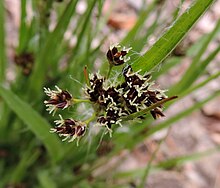heath wood-rush
Search
Wikipedia
| Luzula multiflora | |
|---|---|

| |
|
Scientific classification | |
| Kingdom: | Plantae |
| Clade: | Tracheophytes |
| Clade: | Angiosperms |
| Clade: | Monocots |
| Clade: | Commelinids |
| Order: | Poales |
| Family: | Juncaceae |
| Genus: | Luzula |
| Species: |
L. multiflora
|
| Binomial name | |
|
Luzula multiflora | |
| Synonyms[1] | |
| |
Luzula multiflora, the common woodrush[2] or heath wood-rush,[3] is a species of flowering plant in the rush family.
It is native to Europe, eastern Asia, northern Africa, northern North America, including Canada, and in northern regions of the United States.[1] The native status of common woodrush is under some debate. While Flora of North America list it as introduced, the more common opinion is it is a circumpolar species native in North America and in parts of Europe and Asia.[4] The taxonomy of the wood rush complex involving several Luzula spp. has a history of instability. In the past, common woodrush was classified as a variety of a European species, or Luzula campestris multiflora. Both of these species of rush were then also lumped together with another similar species, Luzula echinata (hedgehog woodrush). As a result, Luzula multiflora and Luzula echinata are sometimes confused.[5] Most of the many woodrushes that grow in North America are rather difficult to tell apart. In spite of the resemblance of rushes and woodrushes to grasses or sedges, they have the same number and arrangement of flower parts as lilies.[6]
Common woodrush grows 10 to 40 cm (4 to 16 in) tall with basal leaves 3.5 to 12 cm (1+3⁄8 to 4+3⁄4 in) long and 2 to 6 mm (0.08 to 0.24 in) wide. The flowers have six brown to black tepals 2 to 4 mm (0.08 to 0.16 in) long.[7]
Common woodrush is fairly easy to identify with its leaves fringed with long, white hairs (common for Luzula species) and the terminal, spike clusters of 6-parted flowers on variable length stalks, replaced by round capsules starting in late spring.[4] Common woodrush leaves often turn reddish in response to stressful conditions [8]
Luzula multiflora resembles a grass in its vegetative state, but its seeds and scaly tepals are similar to those of other species in the rush family (Juncaceae). It is also unusual in preferring upland woodland habitats, as most species in the rush family prefer habitats that are more wet and sunny.[5] The habitat for common woodrush is anthropogenic (man-made or disturbed habitats), forest edges, forests, meadows and fields.[9]
References
- ^ a b "Luzula multiflora". Germplasm Resources Information Network (GRIN). Agricultural Research Service (ARS), United States Department of Agriculture (USDA). Retrieved 2018-08-01.
- ^ "Luzula multiflora". Natural Resources Conservation Service PLANTS Database. USDA. Retrieved 24 June 2015.
- ^ BSBI List 2007 (xls). Botanical Society of Britain and Ireland. Archived from the original (xls) on 2015-06-26. Retrieved 2014-10-17.
- ^ a b Chayka, Katy; Dziuk, Peter (2016). "Luzula multiflora (Common Woodrush) Minnesota Wildflowers". Minnesota Wildflowers. Retrieved 2020-04-22.
- ^ a b Hilty, John (2016). "Common Wood Rush (Luzula multiflora)". Illinois Wildflowers. Retrieved 2020-04-22.
- ^ "Luzula multiflora". Native Plant Database. Lady Bird Johnson Wildflower Center, University of Texas at Austin.
- ^ Swab, Janice Coffey (2000). "Luzula multiflora". In Flora of North America Editorial Committee (ed.). Flora of North America North of Mexico (FNA). 22. New York and Oxford – via eFloras.org, Missouri Botanical Garden, St. Louis, MO & Harvard University Herbaria, Cambridge, MA.
- ^ "Common woodrush - Cooperative Extension: Maine Wild Blueberries - University of Maine Cooperative Extension".
- ^ "Luzula multiflora (common wood rush)". Go Botany. New England Wildflower Society. Retrieved 2020-04-22.
- Lejeune, Alexandre Louis Simon (1811). Flore des Environs de Spa. 1. p. 169.
- Kirschner, J. (1990). "Luzula multiflora and allied species (Juncaceae): a nomenclatural study". Taxon. 39 (1): 106–114. doi:10.2307/1223198. JSTOR 1223198.
- Kirschner, J. (2001). "(1500) Proposal to conserve the name Luzula multiflora (Juncaceae)". Taxon. 50: 1190–1191. doi:10.2307/1224743. JSTOR 1224743.
External links
- NatureServ: Luzula multiflora subspecies info-listings
-
 Data related to Luzula multiflora at Wikispecies
Data related to Luzula multiflora at Wikispecies
| Wikimedia Commons has media related to Luzula multiflora. |
- Luzula
- Flora of Canada
- Flora of the Northern United States
- Flora of the Northeastern United States
- Flora of the Northwestern United States
- Flora of the Southwestern United States
- Flora of the Appalachian Mountains
- Flora of the Great Lakes region (North America)
- Flora of the Rocky Mountains
- Flora of California
- Plants described in 1794
- Poales stubs

